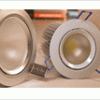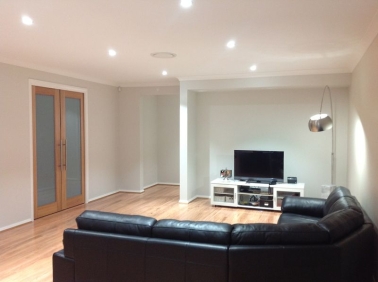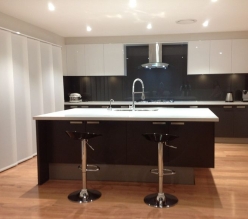
The Myths and Truths of LED Downlights Exposed (part 2)
By Wattsaver Lighting|July 29, 2013
What about 240V GU10’s I hear you say. These are easy to install and you can change them yourself. And some of them out put a nice light. Yes this is true but LEDs are low voltage DC devices and in that GU10 is a tiny embedded switch- mode that drops the 240V AC mains into low voltage DC to drive the led chips. This large drop in voltage generates a lot of heat and the driver is snug inside the luminary right behind the hot chip. Add this to Australian summer temps and I think 240V GU10’s will have a short life. So make sure the price is right and your happy to take them back to the shop (we all know which one) and go up the ladder yourself to put the new one in.
This leads nicely to service life which includes my favourite topic, led drivers. If an LED light does not realize its service life then the return on investment goes out the window. So it has to last. I am not going to go into too much detail here, just to say poor quality LED chips will fade and it is noticeable at the 2000 hour mark. I have been manufacturing and importing LED lighting for 5 years, so I’ve had time to see it. I deal with LED chip quality in other blogs but just because an LED light is bright when you purchase it does not make it a good product. Always ask to see the chip data sheet. A good supplier will know precisely what chip is in their product. I have electrical engineers buy my lights and they all open the light and check the chip temperature. It’s not hard to do and if you are paying a lot of money for a product why not do this. I’ll post some DIY info.
Chips aside the main reason your LED Light will catastrophically fail, is driver failure. I have rubbish bags full of failed switch-mode power supplies, all pulled from LED products. I now only buy LED drivers directly from the reputable manufacturers. These are branded drivers from the manufacturer directly. There are copies coming out of China and unless you dissect them you cannot tell a counterfeit led driver from the real one.
As I have said altready, Led drivers drop 240V to low voltage DC and unless they are designed well, they will be inefficient and run hot. Heat and electrolytic capacitors don’t mix. There is a relationship between capacitor temperature and life expectancy. So mix this with Australian heat and we can explain why LED lighting quality is an issue in Australia.
So take home points
If longevity is important do not buy an LED driver embedded in the luminary where it gets hot and cannot be replaced.
Ensure the driver is a branded product from a reputable manufacturer and that a reinstallation warranty applies to the driver.
Is the LED downlight bright enough to be useful and will it stay that way. Like all semi-conductors LED chips are damaged by heat. Most people are surprised to learn that LED chips emit heat. About 40% of the power going into an LED chip is wasted as heat. Actually they conduct heat not radiate it which is why you see big heatsinks attached to an LED light.
Over the life of a good quality correctly heat sunk LED chip, the chip slowly fades until at 50,000 hours it retains 70% of its starting brightness.
So the first point is that the brighter the starting point of an LED chip the brighter the potential finishing point.(I said potential). Wattsaver sometimes gets complaints that our lights are too bright. I see it on the forums. Some are even stating they are going to buy a less bright light. I say run them dimmed for the first 3 -5 years and know you have a product that will have a useful brightness for many years.
The rate of LED fade is just as important and is determined by how hot the diode junction gets which is determined by the heatsink, driving current and chip quality. Wattsaver downlights have massive heatsinks and our chips run cool, the heat sink is cuddly warm. This is the first thing customers notice when they directly compare our product. Others have either too hot to hold heatsinks or the heatsink is oddly very cool. If the hestsink is getting too hot, it is undersized for the LED chip wattage. If it’s too cool then there is poor transference of heat from the chip to the heatsink.
The other trick used by poor quality manufacturers to improve the initial performance of their products is to run them too hard (over drive), push the current too high. This makes them appear bright in the showroom but what about in a years’ time? Again these products will run very hot. Another important characteristic of LED chips is that the hotter they get the less light they output. This is a condition of voltage drop but it means simply:
Hot running LEDs output less light and fade faster
I have potential customers come in my show room and they bring in some super led downlight they got from the lighting shop next door. I had one guy tell me “oh look at this it has a small heatsink, yours is too large. Look at Apple computers” he said”, “good design is getting smaller, not bigger”. When I explained that his 15W downlight had insufficient heatsink he stated that this was a super material and he made me feel, it was cold, yet it had been running 20 minutes. His claim of a super material fell over when he told me the light cost $14.95.
To be continued....
This leads nicely to service life which includes my favourite topic, led drivers. If an LED light does not realize its service life then the return on investment goes out the window. So it has to last. I am not going to go into too much detail here, just to say poor quality LED chips will fade and it is noticeable at the 2000 hour mark. I have been manufacturing and importing LED lighting for 5 years, so I’ve had time to see it. I deal with LED chip quality in other blogs but just because an LED light is bright when you purchase it does not make it a good product. Always ask to see the chip data sheet. A good supplier will know precisely what chip is in their product. I have electrical engineers buy my lights and they all open the light and check the chip temperature. It’s not hard to do and if you are paying a lot of money for a product why not do this. I’ll post some DIY info.
Chips aside the main reason your LED Light will catastrophically fail, is driver failure. I have rubbish bags full of failed switch-mode power supplies, all pulled from LED products. I now only buy LED drivers directly from the reputable manufacturers. These are branded drivers from the manufacturer directly. There are copies coming out of China and unless you dissect them you cannot tell a counterfeit led driver from the real one.
As I have said altready, Led drivers drop 240V to low voltage DC and unless they are designed well, they will be inefficient and run hot. Heat and electrolytic capacitors don’t mix. There is a relationship between capacitor temperature and life expectancy. So mix this with Australian heat and we can explain why LED lighting quality is an issue in Australia.
So take home points
If longevity is important do not buy an LED driver embedded in the luminary where it gets hot and cannot be replaced.
Ensure the driver is a branded product from a reputable manufacturer and that a reinstallation warranty applies to the driver.
Is the LED downlight bright enough to be useful and will it stay that way. Like all semi-conductors LED chips are damaged by heat. Most people are surprised to learn that LED chips emit heat. About 40% of the power going into an LED chip is wasted as heat. Actually they conduct heat not radiate it which is why you see big heatsinks attached to an LED light.
Over the life of a good quality correctly heat sunk LED chip, the chip slowly fades until at 50,000 hours it retains 70% of its starting brightness.
So the first point is that the brighter the starting point of an LED chip the brighter the potential finishing point.(I said potential). Wattsaver sometimes gets complaints that our lights are too bright. I see it on the forums. Some are even stating they are going to buy a less bright light. I say run them dimmed for the first 3 -5 years and know you have a product that will have a useful brightness for many years.
The rate of LED fade is just as important and is determined by how hot the diode junction gets which is determined by the heatsink, driving current and chip quality. Wattsaver downlights have massive heatsinks and our chips run cool, the heat sink is cuddly warm. This is the first thing customers notice when they directly compare our product. Others have either too hot to hold heatsinks or the heatsink is oddly very cool. If the hestsink is getting too hot, it is undersized for the LED chip wattage. If it’s too cool then there is poor transference of heat from the chip to the heatsink.
The other trick used by poor quality manufacturers to improve the initial performance of their products is to run them too hard (over drive), push the current too high. This makes them appear bright in the showroom but what about in a years’ time? Again these products will run very hot. Another important characteristic of LED chips is that the hotter they get the less light they output. This is a condition of voltage drop but it means simply:
Hot running LEDs output less light and fade faster
I have potential customers come in my show room and they bring in some super led downlight they got from the lighting shop next door. I had one guy tell me “oh look at this it has a small heatsink, yours is too large. Look at Apple computers” he said”, “good design is getting smaller, not bigger”. When I explained that his 15W downlight had insufficient heatsink he stated that this was a super material and he made me feel, it was cold, yet it had been running 20 minutes. His claim of a super material fell over when he told me the light cost $14.95.
To be continued....


